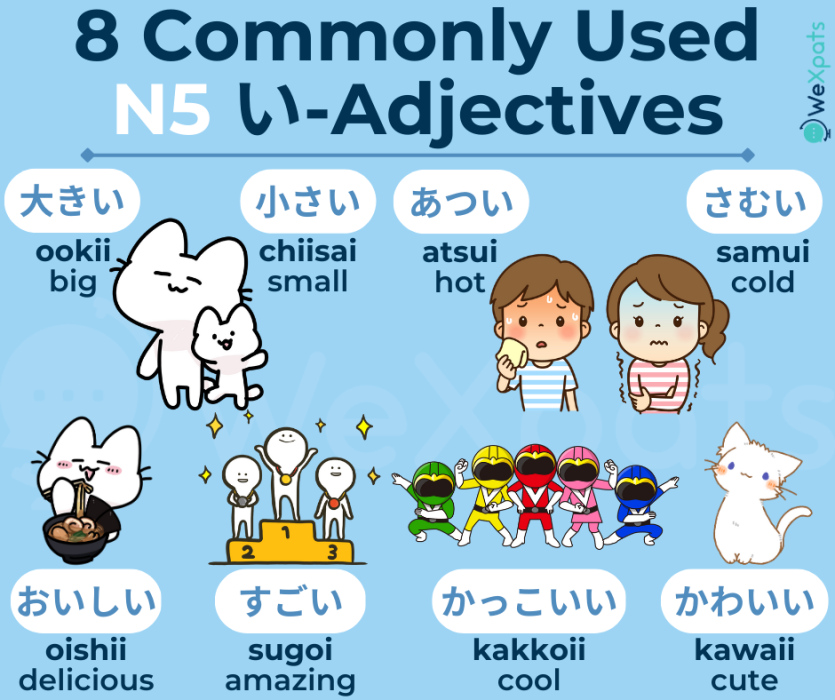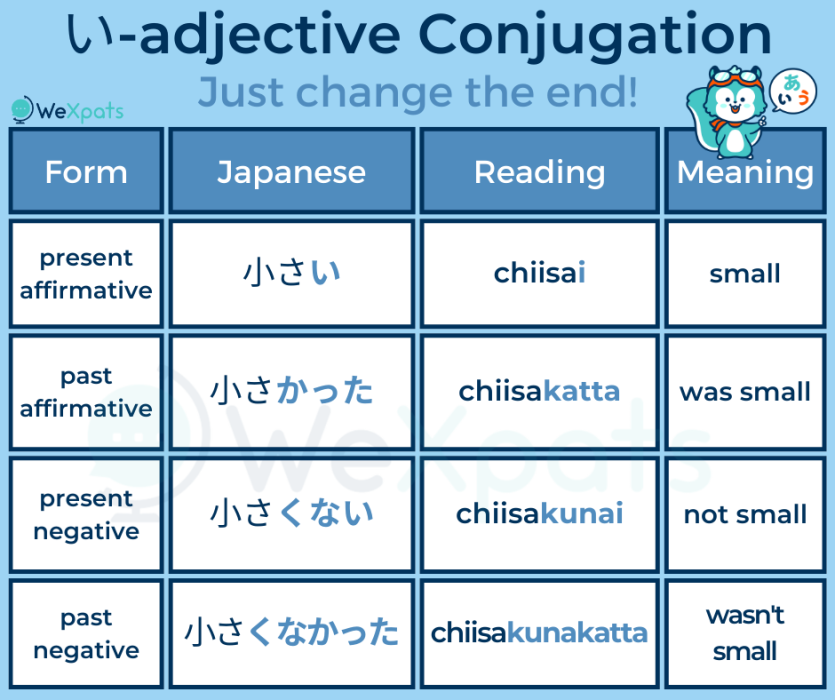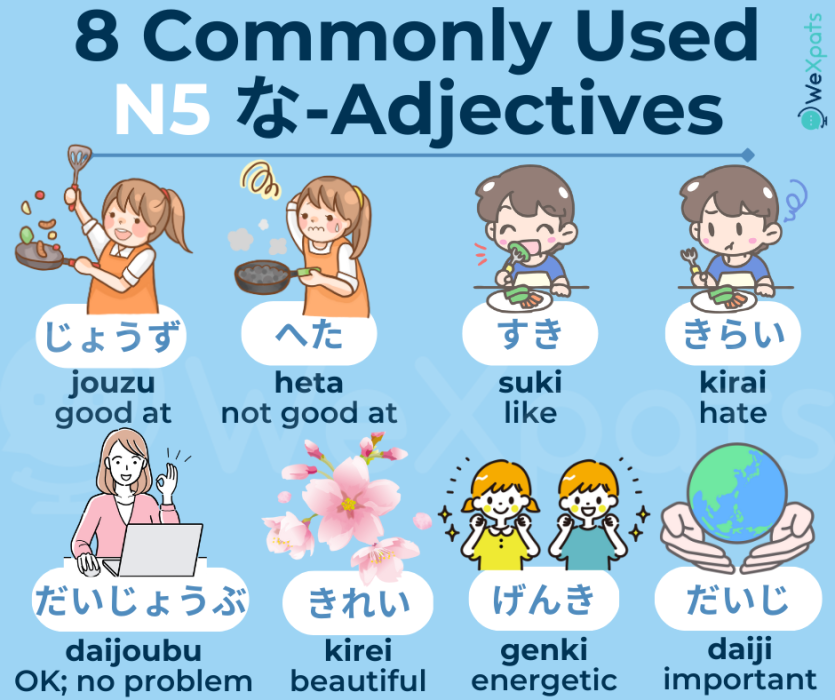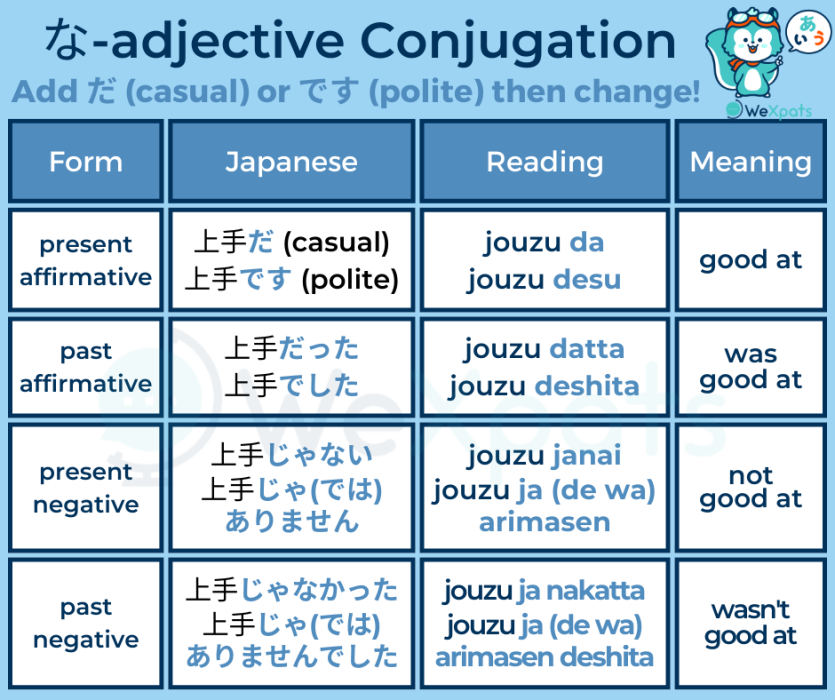Do you know the difference between i-adjectives and n-adjectives? We compiled a useful list of 90 adjectives you need to know to pass the N5 - and just to get by in daily conversations!
Table of Contents
What are い and な Adjectives?
Japanese adjectives are really important because they make up a huge part of reactions - something we often do in conversation. If you’re familiar with Japanese media like anime or dramas or variety shows, you will often hear reactions like “Sugoi!” “Kawaii!” “Oishii!” and so on.
Japanese adjectives are generally split into 2 types.
-
い形容詞 (i-keiyoushi) - adjectives that end with い (i). They often describe emotions or feelings.
-
な形容詞 (na-keiyoushi) or 形容動詞 (keiyoudoushi) - adjectives that require な (na) between the adjective and noun to modify a noun. They often describe a state or condition.
While people familiar with common adjectives probably already know some beyond the N5 level, we compiled a thorough list of 92 adjectives you will need to know at the most basic level. Check them out below!
Writer's Pick
More on I-adjectives

い-形容詞 or i-adjectives are adjectives that end with い (i) that you can stick directly with a noun.
For example, you can say 小さい猫 (chiisai neko) - a small cat.
You can also often use these words by themselves in casual conversation to react to something. Declaring “かわいい (kawaii)!” for example would be the equivalent of “How cute!!”
In order to conjugate i-adjectives to express past tense, polarity, etc., you have to change the i to another form.
The chart below shows the basics.

Thus 小さい猫 (chiisai neko) becomes:
-
小さかった猫 (chiisakatta neko) - cat that was small
-
小さくない猫 (chiisakunai neko) - cat that isn’t small
-
小さくなかった猫 (chiisakunakatta neko) - cat that wasn’t small
N5 I-adjectives List
Here’s a comprehensive list of 63 N5 level i-adjectives that often appear on the test.
Note: The Kanji characters you need to know along with the hirgana at the N5 level are in BOLD letters.
|
おおきい ookii |
大きい |
big |
|
ちいさい chiisai |
小さい |
small |
|
かわいい kawaii |
可愛い |
cute |
|
かっこいい kakkoii |
cool; attractive |
|
|
あたらしい atarashii |
新しい |
new |
|
ふるい furui |
古い |
old (for objects and concepts, not people) |
|
あかるい akarui |
明るい |
bright; light |
|
くらい kurai |
暗い |
dark; gloomy |
|
はやい hayai |
早い |
fast; early |
|
はやい hayai |
速い |
fast (speed) |
|
おそい osoi |
遅い |
late; slow |
|
あつい atsui |
暑い |
hot (weather) |
|
あつい atsui |
熱い |
hot (temperature) |
|
さむい samui |
寒い |
cold |
|
あたたかい atatakai |
暖かい |
warm (weather, clothes, color) |
|
あたたかい atatakai |
温かい |
warm (temperature, words/feeling) |
|
つめたい tsumetai |
冷たい |
cold (to touch, attitude) |
|
すずしい suzushii |
涼しい |
cool (weather) |
|
ぬるい nurui |
lukewarm |
|
|
たかい takai |
高い |
high; tall; expensive |
|
ひくい hikui |
低い |
short; low |
|
せがたかい se ga takai |
背が高い |
tall (person) |
|
せがひくい se ga hikui |
背が低い |
short (person) |
|
やすい yasui |
安い |
inexpensive; cheap |
|
ふとい futoi |
太い |
fat; thick |
|
ほそい hosoi |
細い |
thin; skinny |
|
ひろい hiroi |
広い |
wide; spacious |
|
せまい semai |
狭い |
narrow |
|
おおい ooi |
多い |
many; a lot |
|
すくない sukunai |
少ない |
few |
|
おもい omoi |
重い |
heavy |
|
かるい karui |
軽い |
light |
|
おもしろい omoshiroi |
面白い |
interesting |
|
たのしい tanoshii |
楽しい |
fun |
|
つまらない |
boring |
|
|
つよい tsuyoi |
強い |
strong |
|
よわい yowai |
弱い |
weak |
|
むずかしい muzukashii |
難しい |
difficult |
|
やさしい yasashii |
易しい |
easy; simplistic |
|
ながい nagai |
長い |
long |
|
みじかい mijikai |
短い |
short |
|
おいしい oishii |
美味しい |
delicious; tasty |
|
まずい mazui |
不味い |
tastes bad; unwise; terrible |
|
きたない kitanai |
汚い |
dirty; cluttered |
|
あぶない abunai |
危ない |
dangerous |
|
いたい itai |
痛い |
painful |
|
あまい amai |
甘い |
sweet |
|
からい karai |
辛い |
spicy |
|
まるい marui |
丸い |
round; circular |
|
ほしい hoshii |
欲しい |
want |
|
うるさい urusai |
煩い |
noisy; loud |
|
わかい wakai |
若い |
young |
|
いそがしい isogashii |
忙しい |
busy |
|
あつい atsui |
厚い |
thick; heavy |
|
うすい usui |
薄い |
thin; light (taste) |
|
あかい akai |
赤い |
red |
|
あおい aoi |
青い |
blue |
|
きいろい kiiiroi |
黄色い |
yellow |
|
くろい kuroi |
黒い |
black |
|
しろい shiroi |
白い |
white |
|
すごい sugoi |
凄い |
amazing; great |
|
いい/よい ii / yoi |
良い |
good |
|
わるい warui |
悪い |
bad |
Note: いい at the end of the list is a special case. For the present affirmative tense, it’s read いい (ii), but in other forms, it uses the base よい (yoi).
Thus:
- present affirmative: いい (ii)
- past affirmative: よかった (yokatta)
- present negative: よくない (yokunai)
- past negative: よくなかった (yokunakatta)
More on Na-adjectives

な‐形容詞 or na-adjectives - also known as 形容動詞 (keiyoudoushi) require a な (na) in between the adjective and the noun. When using just the adjective however, such as when using it as a reaction, you don’t need to add the な (na).
Eg. きれいな花 (kirei na hana - a beautiful flower) vs “きれい!” (Kirei! - How beautiful!)
Conjugating na-adjectives is a little different than i-adjectives. Instead of conjugating the word itself, you must add だ (da) or です (desu) and then conjugate those. だ is the casual form of です.
Please consult the chart below:

Note: We simply separated the examples by casual and polite. You can of course say 上手ではない (Jouzu de wa nai) instead of 上手じゃない (Jouzu janai), which makes it more polite. However, it's not often said as much as the others.
Also, you would usually never use じょうず (jouzu) to talk about yourself; you only use it to talk about other people. You can use other words like 上手い (umai) which is quite casual or 得意 (tokui) when talking about something you yourself are good at. (Tokui is an N3 level word, as is its opposite 苦手 nigate.)
N5 Na-adjectives List
Here’s a comprehensive list of 29 N5 level na-adjectives that often appear on the test and are commonly used in daily life.
Note: The Kanji characters for this particular list are not required to be known at the N5 level. However, they are listed for your benefit should you like to study them in advance.
|
じょうず jouzu |
上手 |
good at; skilled |
|
へた heta |
下手 |
not good at |
|
すき suki |
好き |
like |
|
きらい kirai |
嫌い |
hate; dislike |
|
だいすき daisuki |
大好き |
love; like a lot |
|
だいきらい daikirai |
大嫌い |
strong hate |
|
きれい kirei |
綺麗 |
beautiful; clean |
|
ハンサム hansamu |
handsome |
|
|
しずか shizuka |
静か |
quiet |
|
にぎやか nigiyaka |
賑やか |
loud; busy; bustling |
|
げんき genki |
元気 |
energetic; lively |
|
たいせつ taisetsu |
大切 |
important; dear |
|
だいじ daiji |
大事 |
important |
|
いや iya |
嫌 |
unpleasant; undesirable |
|
だいじょうぶ daijoubu |
大丈夫 |
OK; no problem |
|
いろいろ iroiro |
色々 |
various |
|
けっこう kekkou |
結構 |
wonderful; satisfactory, OK; enough |
|
たいへん taihen |
大変 |
very; immense; greatly; terrible; difficult |
|
たくさん takusan |
沢山 |
many; a lot |
|
ほんとう hontou |
本当 |
real; truth |
|
まっすぐ massugu |
真っ直ぐ |
direct; straight (ahead); straightforward; honest |
|
じょうぶ joubu |
丈夫 |
strong; healthy; durable |
|
りっぱ rippa |
立派 |
impressive; splendid; praiseworthy; indisputable |
|
べんり benri |
便利 |
convenient; useful |
|
ゆうめい yuumei |
有名 |
famous |
|
ひま hima |
暇 |
free time |
|
しつれい shitsurei |
失礼 |
rude; impolite |
|
だめ dame |
駄目 |
no good |
|
ぜったい zettai |
絶対 |
absolute; definite |




































